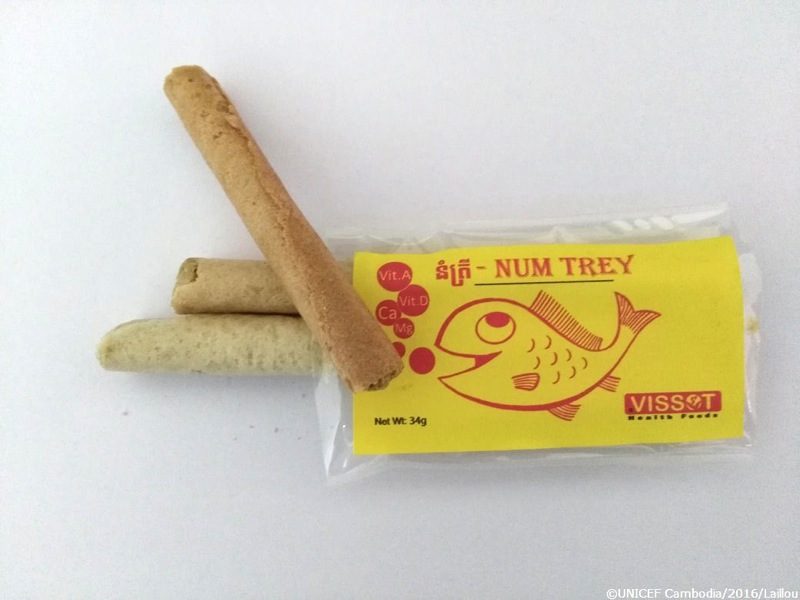A healthy new snack supplement for malnourished children that was created specifically to please the Cambodian palate will be swimming into health centers by the end of the year for children aged 2 years or younger.
Similar in flavor to unhealthy snacks sold at corner stores, the wafer and filling—made of fish, rice, soy and mung beans—is the latest salvo in an effort to reduce child deaths attributed to malnutrition, which numbered 4,500 in 2014.

Unicef and the Health Ministry want to produce enough of the snack, dubbed Num Trey, or Fish Snack in Khmer, to supply them for free to all malnourished children treated in Cambodia’s health centers.
The problem with insufficient nutrition is widespread. Ten percent of Cambodian children under the age of 5 are acutely malnourished, 32 percent are considered stunted and 24 percent are underweight, according to the latest Cambodia Health and Demographic Survey. Stunted children face long-term physical and mental problems that interfere with education and employment.
Researchers were determined to create a snack that children would willingly eat. Num Trey, with its slightly fishy taste, was tested in 27 communes in Phnom Penh, and it provided the same weight gain and weight-for-height gain of a widely used alternative, said Frank Wieringa, a researcher for the French government’s Institute For Development.
The paste-filled wafer will be produced by Vissot, a Phnom Penh-based food company, which had been certified by the Health Ministry to manufacture the snack.
Num Trey currently costs more to produce than the standard malnutrition treatment, which costs $3 per kg, but Dr. Wieringa said he expects Num Trey to cost $2 per kg when Vissot is producing at full capacity.
“In principle, the processes are all there,” he said. “It’s just a question of getting the higher capacity machinery and start producing.”
Dr. Wieringa said he hopes Cambodia will be producing Num Trey at full capacity by the end of the year. The use of Cambodian agricultural products will allow for sustainable production, according to a Unicef statement.
The team of agencies is still testing and analyzing a second version of the snack, as well as investigating whether the product can promote growth, Dr. Wieringa said.
During trials, researchers found that without proper instruction for families, children were not actually eating the snacks at home as they should.
“That is something which is not a problem of the food product itself, but it’s something we need to work on in Cambodia,” Dr. Wieringa said.
Previously, Dr. Wieringa said that eating three to four wafers a day in addition to regular meals should give children 2 years old and younger the nutrients they need for their development.
The Health Ministry could not be reached for comment.